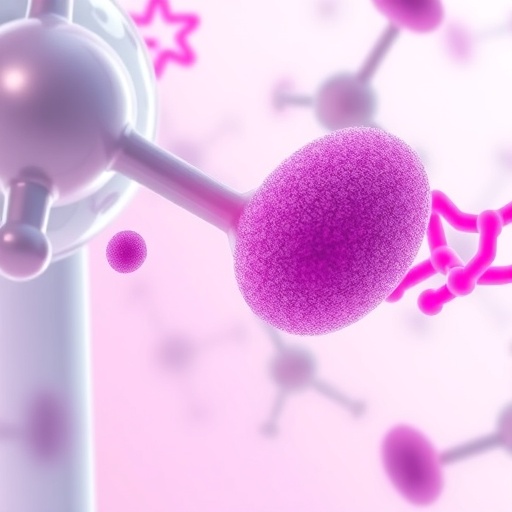
In the ever-evolving field of chemical research, a groundbreaking study has emerged, highlighting innovative approaches to synthesizing multifunctionalized (oxo)indoles. Authored by a team of eminent scientists including Wang, Bf., Qiu, Z., and Lian, F., this study elaborates on the use of O-selective interception of zwitterionic intermediates with N=O. The implications of this work are set to reverberate through various fields, particularly medicinal chemistry, where indoles play a critical role in drug discovery and development.
Indoles, known for their versatile biological activities, form the backbone of many pharmaceutical compounds. This new research illustrates a novel method for constructing such compounds by focusing on the strategic interception of a zwitterionic intermediate, a transient species that possesses both positive and negative charges. This method not only offers enhanced precision in the synthesis process but also expands the functionalization of indoles, paving the way for new therapeutic agents.
The study meticulously details the complex reaction pathways involved in this O-selective interception method. It draws on a robust understanding of reaction kinetics and the influence of electrophilic and nucleophilic species in forming stable intermediates. By optimizing conditions to favor the zwitterionic state, researchers were able to tailor the functionalization of indoles while minimizing byproduct formation, a common hurdle in traditional synthesis approaches.
One of the most remarkable aspects of this research is its potential to streamline the development of novel compounds that may lead to breakthroughs in treating various health conditions. The versatility of the newly synthesized (oxo)indoles opens a plethora of avenues for exploring their pharmacological properties. The authors emphasize that such compounds could exhibit enhanced bioactivity due to their multifunctional nature, marking a significant leap from conventional indole derivatives.
Moreover, the research provides insightful data on the mechanistic aspects of the synthesis process. Utilizing advanced spectroscopic methods, the authors were able to elucidate the electronic properties of the zwitterionic intermediate. This reveals critical information about how different substituents influence the stability and reactivity of the compound, an aspect that can greatly impact drug efficacy and safety.
The study also pays homage to the historical significance of indoles in medicinal chemistry. From their initial discovery to their widespread application in various therapeutic areas, indoles have remained a mainstay in the pharmaceutical industry. This latest innovation serves as a testament to the continued relevance of indole derivatives in addressing contemporary health challenges.
Furthermore, the paper emphasizes the importance of interdisciplinary collaboration in advancing chemical research. By bringing together expertise from synthetic chemistry, molecular biology, and pharmacology, the authors demonstrate how collaborative efforts can lead to innovative solutions that may have once seemed elusive. Their work exemplifies how cross-disciplinary approaches are essential for pushing the frontiers of science.
As the study gains traction among researchers, it raises intriguing questions about further modifications of the indole framework. The authors propose several future directions for research that could include exploring alternative zwitterionic intermediates or integrating other functional groups to enhance the efficacy of the synthesized compounds. Such explorations could yield new classes of molecules with unparalleled properties.
In addition, public interest in synthetic methodologies has surged in recent years, driven by the quest for more sustainable and efficient approaches to chemical synthesis. The authors make a compelling argument that by improving the synthesis of (oxo)indoles, we can move towards greener principles of chemistry, reducing waste and harnessing the full potential of available materials. This aligns with the global effort towards sustainable practices within the scientific community.
The implications of this research extend beyond theoretical exploration; they tap into the pressing need for innovative drug development strategies in an era where traditional methods are proving increasingly inadequate against rising healthcare costs. The conditions created by the authors not only simplify complex reactions but also accelerate the timeline for drug discovery—a welcome development in today’s fast-paced scientific landscape.
As readers delve into the intricacies of the study, it’s clear that the research presented by Wang, Qiu, and Lian is more than just a technical achievement; it is an invitation to reflect on the future of chemical synthesis. By embracing novel pathways and fostering creative problem-solving, scientists can propel the field towards new horizons—a vision where the full capabilities of indoles can be realized.
In conclusion, the construction of multifunctionalized (oxo)indoles via selective interception of zwitterionic intermediates with N=O is a landmark contribution to the field of medicinal chemistry. The study not only enriches our understanding of indole chemistry but also sets the stage for innovative therapeutic discoveries that could significantly alter patient care. The collaborative nature of this research, coupled with its focus on practical applications, promises to inspire future generations of chemists and medicinal researchers.
Through this meticulously crafted study, readers are invited to engage with the complex yet fascinating world of synthetic chemistry. The work serves as a clarion call for further exploration and innovation, heralding a new era in the quest for effective therapeutic solutions. As the scientific community absorbs the insights presented, the excitement and anticipation for what lies ahead continue to build, marking a pivotal moment in the ongoing journey of chemical research.
Subject of Research: Construction of multifunctionalized (oxo)indoles via O-Selective interception of the zwitterionic intermediate with N=O
Article Title: Construction of multifunctionalized (oxo)indoles via O-Selective interception of the zwitterionic intermediate with N=O
Article References: Wang, Bf., Qiu, Z., Lian, F. et al. Construction of multifunctionalized (oxo)indoles via O-Selective interception of the zwitterionic intermediate with N=O. Mol Divers (2025). https://doi.org/10.1007/s11030-025-11279-3
Image Credits: AI Generated
DOI: 10.1007/s11030-025-11279-3
Keywords: Indoles, multifunctionalization, zwitterionic intermediates, synthetic methodologies, drug discovery, chemistry.
Tags: drug discovery and developmentelectrophilic and nucleophilic speciesenhancing precision in synthesisindoles in medicinal chemistryinnovative approaches in chemical researchmultifunctionalized indoles synthesisO-selective interception methodoptimizing chemical reaction conditionsreaction kinetics in organic synthesisreducing byproduct formationtherapeutic agents from indoleszwitterionic intermediates in chemistry




